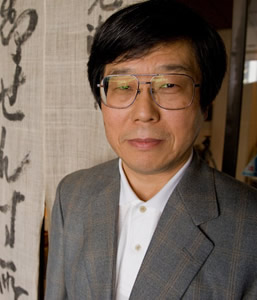 |
 |
 |
| | Home | People behind the Scenes | Yoshihide Fukui | Story 1 |
| |
|
|
We have put together the stories we were not able to introduce in the main section here.

In the Noh play Hanjo, the fan become the centrepiece of the story, playing a key role. Not only in Hanjo, but long ago in Japan, fans were used as a symbol of love. Receiving a fan was actually quite a difficult thing...
 |
Photo: Shigeyoshi Ohi |
We mentioned fans being thrown away after summer was over, and in Hanjo, Hanago, the shite and courtesan, is separated from her lover, and there is a scene where she laments while holding an autumn fan (a play on words as the Japanese word for autumn, aki, also means “to grow tired of someone”). The story Hanjo itself is deeply related to fans, and the way of using fans is shown often. This is where it is used to demonstrate making a promise, a custom that existed from the Heian era. While this custom has dwindled in recent years, in Kyoto when a couple becomes engaged they exchange fans. The woman gives a gold and silver fan painted with black to ward off evil, and the man gives a white fan used in traditional Japanese garments. This custom is said to derive from Hanjo.
Hanjo becomes separated from her lover, and when they meet again unexpectedly they recognize each other by showing their fans, for which there are several explanations. For example, while we call the pattern of chrysanthemums in a bamboo grove “Chrysanthemums in a Grove,” there is one case where the shitekata prepares two of these of the same pattern and passes one to the waki. However based on the chant books, one side is said to be the Yūgao blossom fan, and the other side of the moon fan. In the shite’s chant book, one line reads “a fan to be held while hiding the moon” and because of this a moon is painted on the fan carried by Hanjo which she hides while carrying. The fan carried by the waki is the evening fan. As with the chants, for the Hanjo fan, particularly with the Kanze School, two of the same fans with the Chrysanthemums in a Grove pattern are prepared and presented to face one another. This action was probably originally a man giving a fan to a woman. Receiving a fan is a difficult thing. Even if you don’t intend it to be, receiving the fan can turn into trouble (laughingly). (Yoshihide Fukui’s story)
![]() See here for an explanation of Noh’s Hanjo.
See here for an explanation of Noh’s Hanjo.
 | A fan used in Hanjo with the pattern of chrysanthemums in a bamboo grove Photo by Akira Taniguchi |
| Terms of Use | Contact Us | Link to us |
Copyright©
2026
the-NOH.com All right reserved.